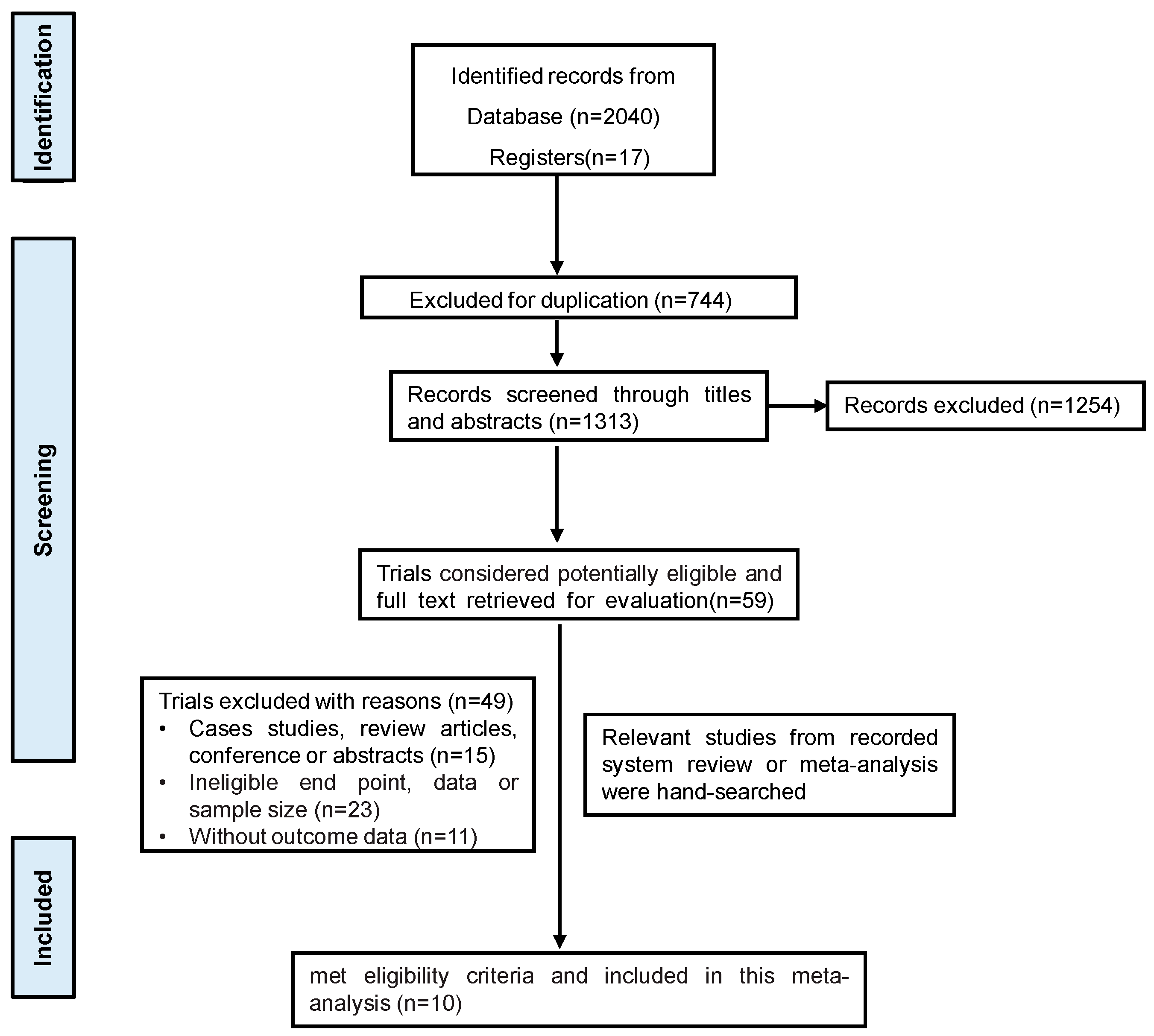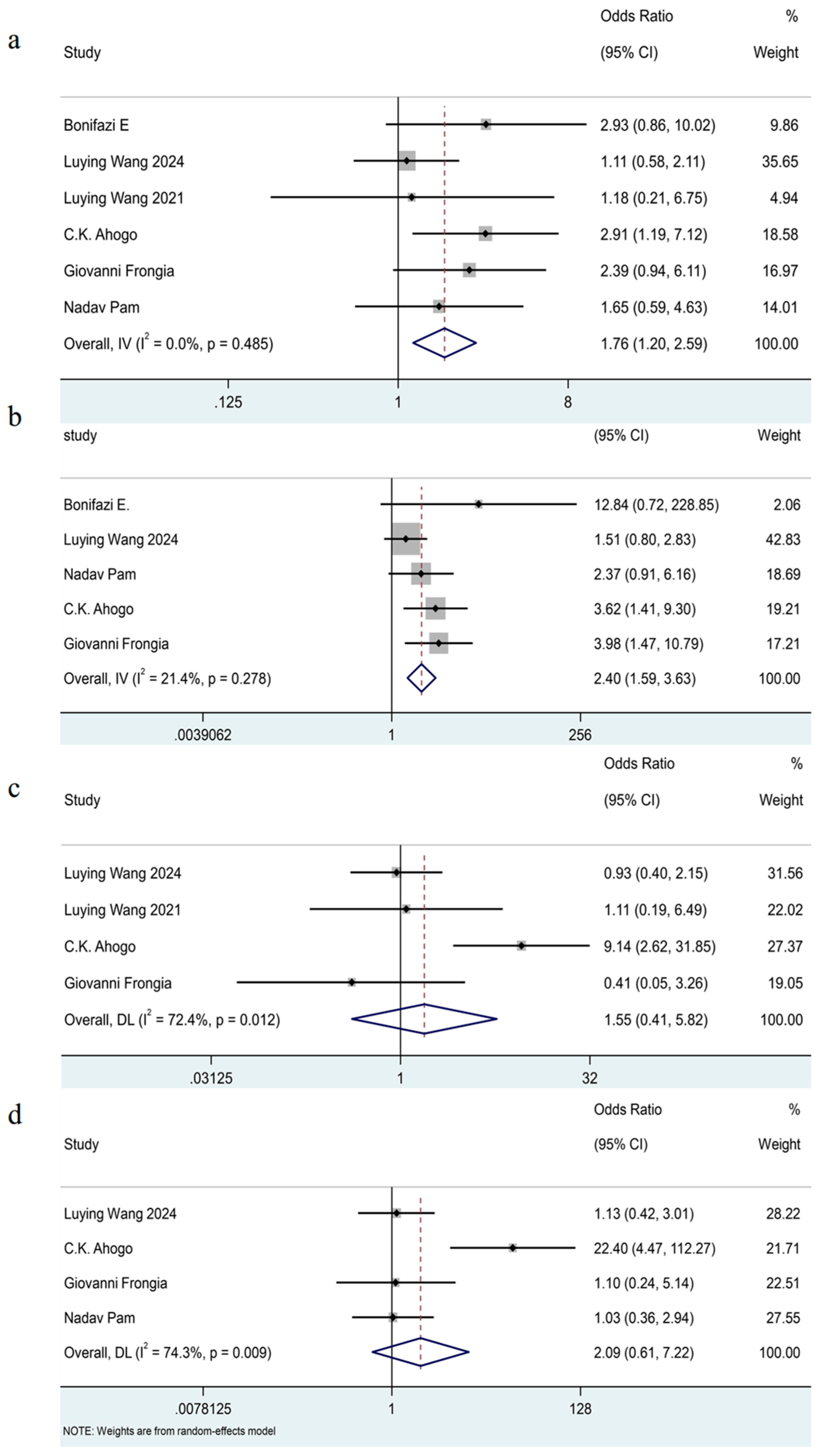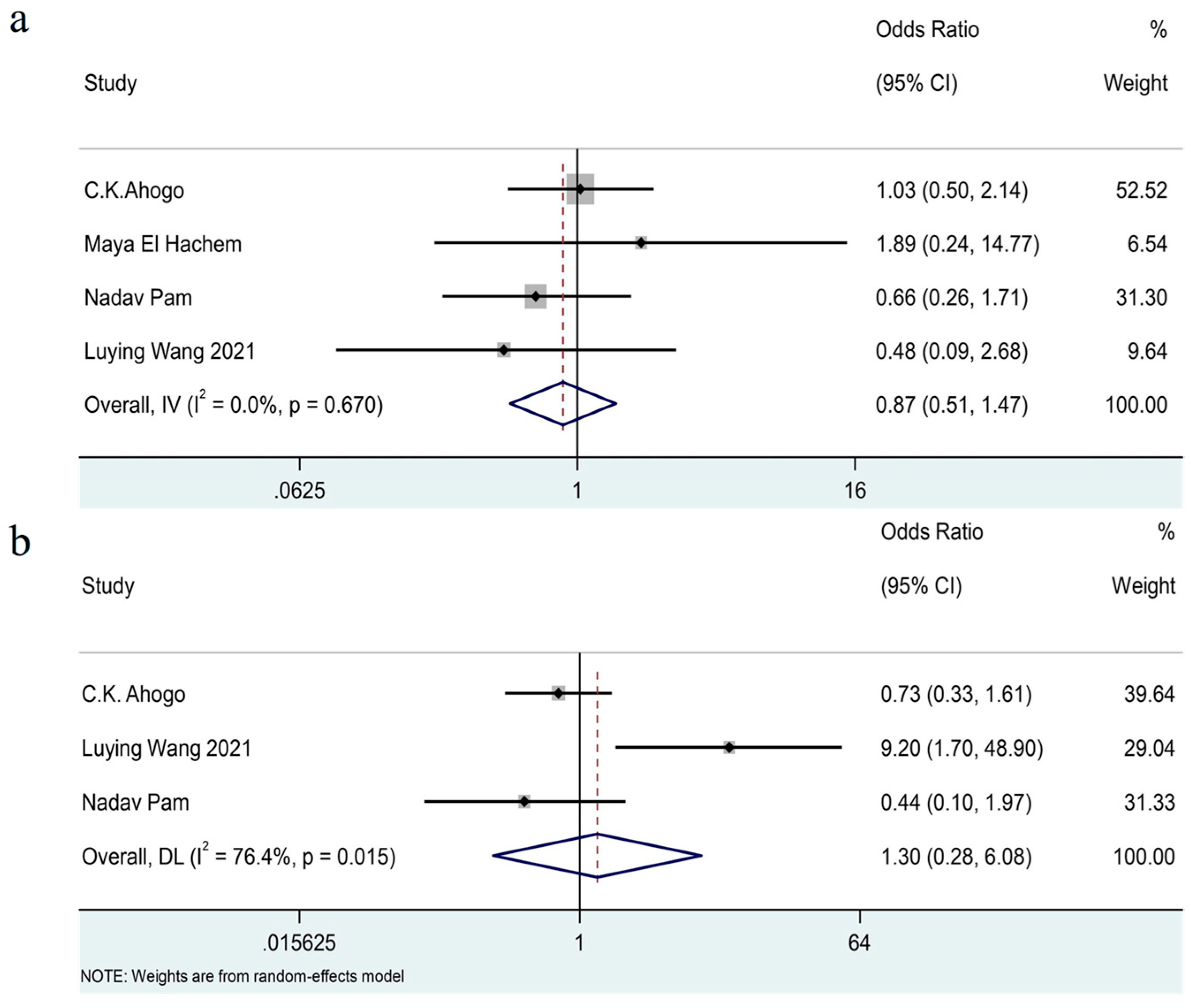Prevalence and Risk Factors Associated with the Recurrence of Infantile Hemangiomas After Discontinuation of Propranolol: A Systematic Review and Meta-Analysis
Abstract
1. Introduction
2. Methods
2.1. Search Strategy
2.2. Eligibility Criteria
2.3. Data Extraction and Quality Assessment
2.4. Outcomes
2.5. Statistical Analysis
3. Results
3.1. Retrieving Identified Studies
3.2. Description of the Included Studies
3.3. Outcomes of the Pooled Studies
3.3.1. Primary Outcomes
3.3.2. Secondary Outcomes
3.4. Risk Factors of Recurrence After Termination of Oral Propranolol
3.4.1. Patient-Related Factors
- Gender (female versus male)
- The sites of IHs (head and neck versus others)
- The distribution of IHs (segmental versus nonsegmental)
- The type of IHs (deep versus superficial)
3.4.2. Treatment-Related Factors
- Age at Treatment Initiation (Later Treatment Initiation Versus Earlier Treatment Initiation)
- The Duration of Treatment (≤6 Months Versus >6 Months)
- The Withdrawal Criteria (Direct Withdrawal Versus Gradual Withdrawal and Withdrawal with 1-Month Maintenance Versus with 3-Month Maintenance)
3.5. The Risk of Bias Due to Missed Results
4. Discussion
5. Conclusions
Supplementary Materials
Author Contributions
Funding
Institutional Review Board Statement
Informed Consent Statement
Conflicts of Interest
References
- Ren, L.; Xu, X.; Liu, X.; Ning, H.; Ding, Q.; Yang, M.; Liang, T. Recent Advances in Propranolol Hydrochloride Formulations for the Treatment of Infantile Hemangiomas. Drug Des. Dev. Ther. 2025, 19, 1163–1183. [Google Scholar] [CrossRef]
- Li, L.L.; Yan, L.; Luo, M.X.; Cai, Y.X.; Mi, X.B.; Zhang, T.D. Propranolol in the Treatment of Infantile Hemangiomas: A Meta-Analysis in Chinese Patients. Pediatr. Dermatol. 2015, 32, e210–e214. [Google Scholar] [CrossRef]
- Muñoz-Garza, F.Z.; Ríos, M.; Roé-Crespo, E.; Bernabeu-Wittel, J.; Montserrat-García, M.T.; Puig, L.; Gich, I.; Baselga, E. Efficacy and Safety of Topical Timolol for the Treatment of Infantile Hemangioma in the Early Proliferative Stage: A Randomized Clinical Trial. JAMA Dermatol. 2021, 157, 583–587. [Google Scholar] [CrossRef]
- Yang, H.; Hu, D.L.; Shu, Q.; Guo, X.D. Efficacy and adverse effects of oral propranolol in infantile hemangioma: A meta-analysis of comparative studies. World J. Pediatr. 2019, 15, 546–558. [Google Scholar] [CrossRef] [PubMed]
- Rešić, A.; Barčot, Z.; Habek, D.; Pogorelić, Z.; Bašković, M. The Evaluation, Diagnosis, and Management of Infantile Hemangiomas-A Comprehensive Review. J. Clin. Med. 2025, 14, 425. [Google Scholar] [CrossRef] [PubMed]
- Shah, S.D.; Baselga, E.; McCuaig, C.; Pope, E.; Coulie, J.; Boon, L.M.; Garzon, M.C.; Haggstrom, A.N.; Adams, D.; Drolet, B.A.; et al. Rebound growth of infantile hemangiomas after propranolol therapy. Pediatrics 2016, 137, e20151754. [Google Scholar] [CrossRef]
- Ahogo, C.K.; Ezzedine, K.; Prey, S.; Colona, V.; Diallo, A.; Boralevi, F.; Taïeb, A.; Léauté-Labrèze, C. Factors associated with the relapse of infantile haemangiomas in children treated with oral propranolol. Br. J. Dermatol. 2013, 169, 1252–1256. [Google Scholar] [CrossRef] [PubMed]
- Bonifazi, E.; Milano, A.; Gambino, A. Prevention and treatment of hemangioma rebound after discontinuation of propranolol. Eur. J. Pediatr. Dermatol. 2014, 24, 35–43. [Google Scholar]
- Mariani, L.G.; Ferreira, L.M.; Rovaris, D.L.; Bonamigo, R.R.; Kiszewski, A.E. Infantile hemangiomas: Risk factors for complications, recurrence and unaesthetic sequelae. An. Bras. Dermatol. 2022, 97, 37–44. [Google Scholar] [CrossRef]
- Zaaroura, H.; Tibi, A.; Avitan-Hersh, E.; Khamaysi, Z. Our Experience in Treating Infantile Hemangioma: Prognostic Factors for Relapse After Propranolol Discontinuation. Adv. Ther. 2025, 42, 537–547. [Google Scholar] [CrossRef]
- Wang, L.; Wang, W.; Zhou, Z.; Li, J.; Li, Z.; Lv, R.; Xu, G.; Bi, J.; Huo, R. Exploration of the optimal time to discontinue propranolol treatment in infantile hemangiomas: A prospective study. J. Am. Acad. Dermatol. 2024, 90, 783–789. [Google Scholar] [CrossRef]
- Mei, Z.; Wang, Q.; Zhang, Y.; Liu, P.; Ge, M.; Du, P.; Yang, W.; He, Y. Risk Factors for Recurrence after anal fistula surgery: A meta-analysis. Int. J. Surg. 2019, 69, 153–164. [Google Scholar] [CrossRef]
- Higgins, J.P.; Thompson, S.G.; Deeks, J.J.; Altman, D.G. Measuring inconsistency in meta-analyses. BMJ 2003, 327, 557–560. [Google Scholar] [CrossRef] [PubMed]
- Lam, T.J.R.; Yang, J.; Poh, J.E.; Ong, M.E.H.; Liu, N.; Yeo, J.W.; Gräsner, J.T.; Masuda, Y.; Ho, A.F.W. Long term risk of recurrence among survivors of sudden cardiac arrest: A systematic review and meta-analysis. Resuscitation 2022, 176, 30–41. [Google Scholar] [CrossRef]
- Wu, Y.; Zhao, P.; Song, W.; Lu, W.; Dai, T.; Wang, L. Our experience with propranolol for infantile hemangioma. Ski. Res. Technol. 2023, 29, e13310. [Google Scholar] [CrossRef]
- Wang, L.; Li, S.; Gao, Q.; Lv, R.; Xu, G.; Li, X.; Bi, J.; Huo, R. Oral propranolol therapy in parotid hemangiomas: A retrospective comparison with other infantile hemangiomas. Head Neck 2021, 43, 1553–1562. [Google Scholar] [CrossRef]
- Pam, N.; Kridin, K.; Khamaysi, Z. Propranolol for infantile hemangioma: Evaluating efficacy and predictors of response and rebound growth. Dermatol. Ther. 2021, 34, e14936. [Google Scholar] [CrossRef] [PubMed]
- Ji, Y.; Chen, S.; Yang, K.; Zhang, X.; Zhou, J.; Li, L.; Xiang, B.; Qiu, T.; Dai, S.; Jiang, X.; et al. Efficacy and Safety of Propranolol vs Atenolol in Infants With Problematic Infantile Hemangiomas: A Randomized Clinical Trial. JAMA Otolaryngol. Head Neck Surg. 2021, 147, 599–607. [Google Scholar] [CrossRef] [PubMed]
- Frongia, G.; Byeon, J.O.; Mehrabi, A.; Günther, P. Recurrence rate of infantile hemangioma after oral propranolol therapy. Eur. J. Pediatr. 2021, 180, 585–590. [Google Scholar] [CrossRef]
- El Hachem, M.; Gesualdo, F.; Diociaiuti, A.; Berti, I.; Vercellino, N.; Boccaletti, V.; Neri, I.; Porcedda, G.; Greco, A.; Carnevale, C.; et al. Safety and effectiveness of oral propranolol for infantile hemangiomas started before 5 weeks and after 5 months of age: An Italian multicenter experience. Ital. J. Pediatr. 2017, 43, 40. [Google Scholar] [CrossRef]
- Chang, L.; Gu, Y.; Yu, Z.; Ying, H.; Qiu, Y.; Ma, G.; Chen, H.; Jin, Y.; Lin, X. When to stop propranolol for infantile hemangioma. Sci. Rep. 2017, 7, 43292. [Google Scholar] [CrossRef]
- Vercellino, N.; Romanini, M.V.; Pelegrini, M.; Rimini, A.; Occella, C.; Dalmonte, P. The use of propranolol for complicated infantile hemangiomas. Int. J. Dermatol. 2013, 52, 1140–1146. [Google Scholar] [CrossRef]
- Wedgeworth, E.; Glover, M.; Irvine, A.D.; Neri, I.; Baselga, E.; Clayton, T.H.; Beattie, P.E.; Bjerre, J.V.; Burrows, N.P.; Foelster-Holst, R.; et al. Propranolol in the treatment of infantile haemangiomas: Lessons from the European Propranolol In the Treatment of Complicated Haemangiomas (PITCH) Taskforce survey. Br. J. Dermatol. 2016, 174, 594–601. [Google Scholar] [CrossRef]
- Mauguen, C.; Maruani, A.; Barbarot, S.; Abasq, C.; Martin, L.; Herbert, J.; Goronflot, T.; Gourraud, P.A.; Happe, A.; Descatha, A.; et al. Factors associated with early relapse of infantile haemangioma in children treated for at least six months with oral propranolol: A case-control study using the 2014-2021 French Ouest DataHub. Ann. Dermatol. Venereol. 2023, 150, 189–194. [Google Scholar] [CrossRef]
- Johnson, A.; Zhang, H.; Gonzalez, S.R.; Lee, M.; Wei, T.; Richter, G. Presence of estrogen and progesterone receptors in proliferating and involuting infantile hemangiomas. J. Plast. Reconstr. Aesthetic Surg. 2021, 74, 3061–3065. [Google Scholar] [CrossRef]
- Martin, J.M.; Sanchez, S.; González, V.; Cordero, P.; Ramon, D. Infantile hemangiomas with minimal or arrested growth: A retrospective case series. Pediatr. Dermatol. 2019, 36, 125–131. [Google Scholar] [CrossRef] [PubMed]
- Bae, K.N.; Shin, K.; Kim, H.S.; Kim, B.S.; Kim, M.B.; Ko, H.C. Infantile Hemangiomas with Minimal and Arrested Growth: Clinical Features and Treatment Outcomes with 0.5% Topical Timolol Maleate. Ann. Dermatol. 2021, 33, 448–455. [Google Scholar] [CrossRef] [PubMed]
- Bagazgoitia, L.; Hernández-Martín, Á.; Torrelo, A. Recurrence of infantile hemangiomas treated with propranolol. Pediatr. Dermatol. 2011, 28, 658–662. [Google Scholar] [CrossRef]
- Al-Mahdi, A.H.; Al-Sada, M.A. Assessment of Oral Propranolol Administration for Infantile Hemangioma in Oral and Maxillofacial Region Aided by Ultrasonography. J. Craniofac Surg. 2020, 31, 189–192. [Google Scholar] [CrossRef]
- Shehata, N.; Powell, J.; Dubois, J.; Hatami, A.; Rousseau, E.; Ondrejchak, S.; McCuaig, C. Late rebound of infantile hemangioma after cessation of oral propranolol. Pediatr. Dermatol. 2013, 30, 587–591. [Google Scholar] [CrossRef] [PubMed]
- Giachetti, A.; Garcia-Monaco, R.; Sojo, M.; Scacchi, M.F.; Cernadas, C.; Guerchicoff Lemcke, M.; Dovasio, F. Long-term treatment with oral propranolol reduces relapses of infantile hemangiomas. Pediatr. Dermatol. 2014, 31, 14–20. [Google Scholar] [CrossRef]
- Baselga, E.; Dembowska-Baginska, B.; Przewratil, P.; González-Enseñat, M.A.; Wyrzykowski, D.; Torrelo, A.; López Gutiérrez, J.C.; Rychłowska-Pruszyńska, M.; de Lucas-Laguna, R.; Esteve-Martinez, A.; et al. Efficacy of Propranolol Between 6 and 12 Months of Age in High-Risk Infantile Hemangioma. Pediatrics 2018, 142, e20173866. [Google Scholar] [CrossRef]
- Stănciulescu, M.C.; Dorobantu, F.R.; Boia, E.S.; Popoiu, M.C.; Cerbu, S.; Heredea, R.; Iacob, E.R.; Cimpean, A.M.; Caplar, B.D.; Popoiu, A.V. “Face(s)” of a PHACE(S) Syndrome Patient before and after Therapy: Particular Case Report and Review of Literature. Children 2022, 9, 1970. [Google Scholar] [CrossRef]
- Zhan, J.H.; Wei, J.; Liu, Y.J.; Wang, P.X.; Zhu, X.Y. Sepsis-associated endothelial glycocalyx damage: A review of animal models, clinical evidence, and molecular mechanisms. Int. J. Biol. Macromol. 2025, 295, 139548. [Google Scholar] [CrossRef]
- Zhang, T.N.; Huang, X.M.; Goodwin, J.E.; Wen, R.; Liu, Y.P.; Yang, Y.H.; Zhang, T.; Zheng, Y.; Chen, A.Y.; Hao, P.H.; et al. Endothelial CLEC5A drives barrier dysfunction and vascular leakage responsible for lung injury in bacterial pneumonia and sepsis. Sci. Adv. 2025, 11, eadt7589. [Google Scholar] [CrossRef] [PubMed]
- Price, C.J.; Lattouf, C.; Baum, B.; McLeod, M.; Schachner, L.A.; Duarte, A.M.; Connelly, E.A. Propranolol vs corticosteroids for infantile hemangiomas: A multicenter retrospective analysis. Arch. Dermatol. 2011, 147, 1371–1376. [Google Scholar] [CrossRef] [PubMed]
- Chang, L.; Lv, D.; Yu, Z.; Ma, G.; Ying, H.; Qiu, Y.; Gu, Y.; Jin, Y.; Chen, H.; Lin, X. Infantile hemangioma: Factors causing recurrence after propranolol treatment. Pediatr. Res. 2018, 83, 175–182. [Google Scholar] [CrossRef]
- Holm, A.; Graus, M.S.; Wylie-Sears, J.; Tan, J.W.H.; Alvarez-Harmon, M.; Borgelt, L.; Nasim, S.; Chung, L.; Jain, A.; Sun, M.; et al. An endothelial SOX18-mevalonate pathway axis enables repurposing of statins for infantile hemangioma. J. Clin. Investig. 2025, 135, e179782. [Google Scholar] [CrossRef] [PubMed]
- Roca, I.C.; Cojocaru, E.; Rusu, C.D.; Trandafir, L.M.; Săveanu, C.I.; Lupu, V.V.; Butnariu, L.I.; Ţarcă, V.; Moscalu, M.; Bernic, J.; et al. The Role of Natural Extracts in the Management of Infantile Hemangiomas and Vascular Tumors. Pediatr. Health Med. Ther. 2024, 15, 1–16. [Google Scholar] [CrossRef]
- Cai, Y.; Lv, F.; Kaldybayeva, N.; Zhamilya, A.; Wu, Z.; Wu, Y. 15, 16-Dihydrotanshinone I Inhibits Hemangiomas through Inducing Pro-apoptotic and Anti-angiogenic Mechanisms in Vitro and in Vivo. Front. Pharmacol. 2018, 9, 25. [Google Scholar] [CrossRef]
- Page, M.J.; McKenzie, J.E.; Bossuyt, P.M.; Boutron, I.; Hoffmann, T.C.; Mulrow, C.D.; Shamseer, L.; Tetzlaff, J.M.; Akl, E.A.; Brennan, S.E.; et al. The PRISMA 2020 statement: An updated guideline for reporting systematic reviews. BMJ 2021, 372, n71. [Google Scholar] [CrossRef] [PubMed]





| Author | Country | Year | Study Design | Sample Size (N) | Female (%) | Age (Months) (Mean (SD) or Median/Mean (IQR)) | Follow-Up Length (Months) | Quality Assessment & |
|---|---|---|---|---|---|---|---|---|
| Bonifazi E [8] | Italy | 2014 | cohort | 99 | 70.0 | mean: 4.3, range:1–19 | 3 months after discontinuation | 6 |
| Yao Wu [15] | China | 2023 | cohort | 90 | 72.3 | group 1: 4.3 (2.97); group 2: 5.2 (4.57) | range: 5–52 | 7 |
| Luying Wang [11] | China | 2024 | cohort | 150 | 62.7 | group A: 2.80 (2.05–4.40), group B: 3.50 (2.20–4.40), group C: 3.85 (1.73–5.55), group D: 2.70 (2.30–5.20) | 6 months after discontinuation | 8 |
| Luying Wang [16] | China | 2021 | cohort | 100 | 71.0 | group A: median: 3.5, group B: median: 3.7 | 9 months after discontinuation | 9 |
| Nadav Pam [17] | Israel | 2021 | cohort | 206 | 70.9 | 4.8 (3.1) | 4 months after discontinuation | 8 |
| Yi Ji [18] | China | 2021 | RCT | 169 | 76.8 | 2.55 (1.0) | up to 24 | low-risk # |
| Giovanni Frongia [19] | Germany | 2021 | cohort | 198 | 75.0 | 2 (2–4) | median (IQR): 8.5 (7–12.9) | 7 |
| Maya El Hachem [20] | Italy | 2017 | cohort | 343 | 70.8 | group 1: median: 0.8, range: 0–1.1, group 2: median: 9, range 5–90.7 | ≥1 month after discontinuation | 7 |
| Lei Chang [21] | China | 2017 | cohort | 149 | 72.4 | group 1: 3.1 (1.2), group 2: 3.4 (1.3) | range: 6–25 | 6 |
| C.K. Ahogo [7] | France | 2013 | cohort | 158 | 67.1 | ≤5 | >6 months after discontinuation | 9 |
| Study (Author, Year) | Recurrence Rate | Major Recurrence Rate | Potential Risk Factor (s) |
|---|---|---|---|
| Bonifazi E, 2014 [8] | 21/99 | NA | gender, lesion site |
| Yao Wu, 2023 [15] | 27/90 | NA | NA |
| Luying Wang, 2024 [11] | 62/173 * | 25/173 * | gender, lesion site, type of hemangioma, distribution of hemangioma, age at treatment initiation, withdrawal criterion for discontinuation |
| Luying Wang, 2021 [16] | 18/93 $ | 9/93 $ | gender, type of hemangioma, distribution of hemangioma, age at treatment initiation, duration of treatment |
| Nadav Pam, 2021 [17] | 24/206 | 19/206 | gender, lesion site, type of hemangioma, age at treatment initiation, duration of treatment |
| Yi Ji, 2021 [18] | 19/169 | NA | NA |
| Giovanni Frongia, 2021 [19] | 35/198 | NA | gender, lesion site, type of hemangioma, distribution of hemangioma |
| Maya El Hachem, 2017 [20] | 40/343 | NA | NA |
| Lei Chang, 2017 [21] | 26/149 | NA | NA |
| C.K. Ahogo, 2013 [7] | 40/158 | 19/158 | gender, lesion site, type of hemangioma, distribution of hemangioma, age at treatment initiation, duration of treatment |
Disclaimer/Publisher’s Note: The statements, opinions and data contained in all publications are solely those of the individual author(s) and contributor(s) and not of MDPI and/or the editor(s). MDPI and/or the editor(s) disclaim responsibility for any injury to people or property resulting from any ideas, methods, instructions or products referred to in the content. |
© 2025 by the authors. Licensee MDPI, Basel, Switzerland. This article is an open access article distributed under the terms and conditions of the Creative Commons Attribution (CC BY) license (https://creativecommons.org/licenses/by/4.0/).
Share and Cite
Gong, C.; Yue, X.; Zhang, L.; Zhao, X.; Shu, Q. Prevalence and Risk Factors Associated with the Recurrence of Infantile Hemangiomas After Discontinuation of Propranolol: A Systematic Review and Meta-Analysis. J. Clin. Med. 2025, 14, 7846. https://doi.org/10.3390/jcm14217846
Gong C, Yue X, Zhang L, Zhao X, Shu Q. Prevalence and Risk Factors Associated with the Recurrence of Infantile Hemangiomas After Discontinuation of Propranolol: A Systematic Review and Meta-Analysis. Journal of Clinical Medicine. 2025; 14(21):7846. https://doi.org/10.3390/jcm14217846
Chicago/Turabian StyleGong, Chenchen, Xiaojie Yue, Lulu Zhang, Xiong Zhao, and Qiang Shu. 2025. "Prevalence and Risk Factors Associated with the Recurrence of Infantile Hemangiomas After Discontinuation of Propranolol: A Systematic Review and Meta-Analysis" Journal of Clinical Medicine 14, no. 21: 7846. https://doi.org/10.3390/jcm14217846
APA StyleGong, C., Yue, X., Zhang, L., Zhao, X., & Shu, Q. (2025). Prevalence and Risk Factors Associated with the Recurrence of Infantile Hemangiomas After Discontinuation of Propranolol: A Systematic Review and Meta-Analysis. Journal of Clinical Medicine, 14(21), 7846. https://doi.org/10.3390/jcm14217846







